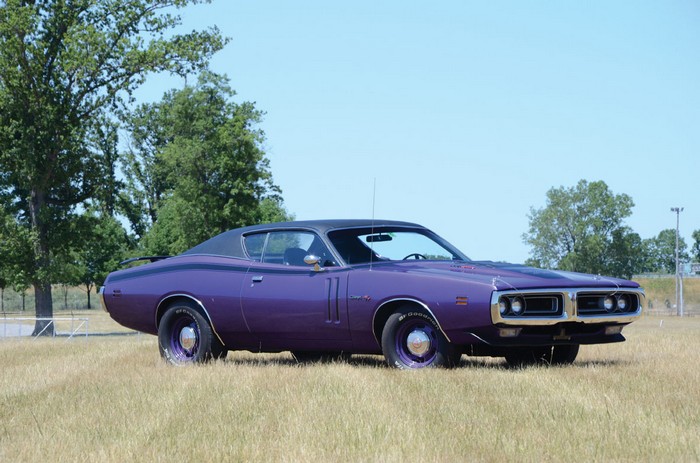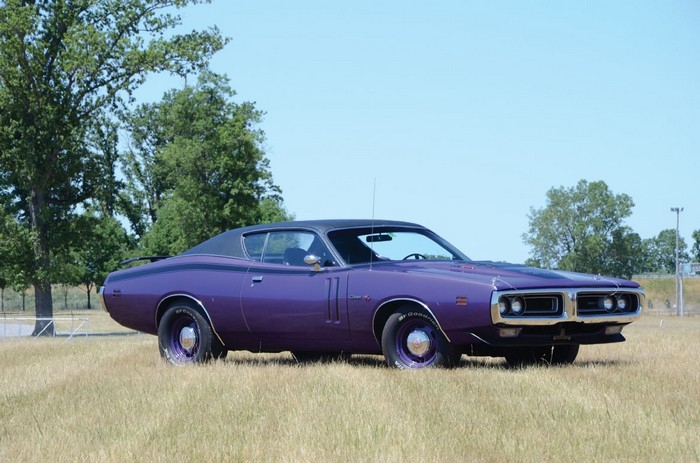
This 1971 Dodge Charger is believed to have been a one-owner vehicle until purchased by the current owner in 2011.
One of only 332 believed to have been built, this desirable 4-speed car is being sold with a Galen Govier report as well as other related paperwork. It is in excellent overall condition inside and out, with excellent panel fit, paint, upholstery and a well-detailed engine bay and chassis.
SCM Analysis
Detailing
| Vehicle: | 1971 Dodge Charger R/T 440 |
| Years Produced: | 1971 |
| Number Produced: | 2,659 |
| Original List Price: | $3,783 |
| SCM Valuation: | $26,000–$57,000 |
| Tune Up Cost: | $150 |
| Distributor Caps: | $23 |
| Chassis Number Location: | VIN plate on the driver’s side instrument panel behind windshield |
| Engine Number Location: | Pad located on the right side of the block to the rear of the engine mount |
| Club Info: | Walter P. Chrysler Club |
| Website: | www.chryslerclub.org |
| Alternatives: | 1971 Plymouth Road Runner and GTX, 1971 Pontiac GTO Judge, 1971 Chevrolet Chevelle SS 454. |
| Investment Grade: | C |
This 1971 Charger R/T, Lot 4127, sold for $36,300, including buyer’s premium, at Auctions America by RM’s Auburn Fall auction in Auburn, IN, on September 1, 2012.
In 1969, Dodge sold 19,298 of the swift, stylish Charger R/T models. In 1970, that same car sold 9,509 units, and in 1971, just 2,659. Those disappointing numbers might imply that the ’71 was a much lesser vehicle than previous Chargers. But the numbers don’t tell the whole story.
The R/T model was the performance leader of the Dodge Charger lineup in 1971, along with the Super Bee. The base engine was the mighty 440-ci V8, sporting a single 4-barrel carb delivering 375 hp. You could also order the 390-hp and Six-Pack and even the legendary 426 Hemi.
Whatever the engine, you backed it up with either a 4-speed manual or the excellent 3-speed TorqueFlite automatic. This was the same basic powertrain that powered Chrysler’s other muscle cars, the Plymouth Road Runner and, until 1971, the Dodge Coronet R/T, as well as the Barracuda and Challenger. And while the sheet metal was different, underneath was the same tried-and-true “B-Body” platform that had been around since 1962.
An all-new look
Design chief Bill Brownlie and his team gave the 1971 Charger a totally new design, with sleek “fuselage” styling that looked much different from the former models while keeping familiar Charger design cues. Car and Driver magazine commented, “A Dodge Charger? A piece of sculpture? Brownlie and his associates have come up with the best-styled new car for 1971… The Charger comes off as anything but a styling compromise. Not only is it apparent to people viewing the car from the outside, but the driver is aware that he is controlling something far from normal as well.”
The 10 cars that Motor Trend nominated for its 1971 Car of the Year award were filled with the new compacts launched that year — Pinto, Vega, and Gremlin — as well as theRiviera/Toronado luxo-barges and Camaro/Firebird and Mustang/Cougar Pony cars.
But they included the ’71 Charger, the only traditional muscle car of the group, saying “It was evident, after the initial success of the ’68–’70 Chargers, the Dodge stylists would have to burn some midnight oil to create a fresh approach that would again make Charger something unique in an industry where very little is unique. As far as the Motor Trend staff is concerned, they succeeded, and won a nomination… The Charger will be examined in the Ride and Drive, in order to determine whether Dodge’s ‘family’ supercar is still a value for the money in comparison to the new econo-cars. There was a time when a supercar didn’t have to defend itself. But that was the mid-’60’s. For ’71, it’s a brand new bag…”
Still a muscle car
It may have been a brand new bag, but that old-time performance was still evident, at least for one last year. Car and Driver recorded 0–60 mph in 6.5 seconds and ran the quarter-mile in 14.8 seconds at 95.7 mph in a Charger equipped with the 440 Magnum and 3-speed TorqueFlite automatic, while Motor Trend saw similar results. That’s not ’68 Hemi Road Runner territory, but then again, the Charger had a nice array of creature comforts, while the ’Runner was a painfully bare-bones, lightweight, all-out speed machine.
The Charger R/T was a very good car for its time, but the times were a changin’. Motor Trend chose Chevy’s Vega as their 1971 Car of the Year, a true sign that the automotive climate was not what it was just two or three years before.
And while Dodge had an excellent year selling more than 60,000 Chargers, only about 10% were performance R/T or Super Bee models. Clearly, America’s love affair with the muscle car was over. Safety concerns were taking the fun out of these cars, with insurance rates going over $1,500 annually for someone with a blemished record — almost half the cost of the car itself.
Plus, the American economy was also falling into a recession, making the purchase of these cars more difficult to justify. Finally, our soldiers returning from Vietnam were coming back older and wiser, and as many were settling down and getting married, they were trading their fast toys for family transportation.
The last of its kind
In today’s market, the 1971 performance cars are often viewed with the same disdain as other ’70s-era vehicles. But the ’71 Charger R/T is much more a classic ’60s muscle machine than a wanna-be ’78 Volaré Road Runner. That means, as prices for the ’60s cars have gotten out of reach for many buyers, these early ’70s cars can be a real bargain, although with the exception of the Pontiac Firebird, 1971 was pretty much the last year for real performance.
We’ve seen Hemi-powered ’71 Chargers reach the $315,000 mark, and the nearly-as-rare 440 Six-Pack ’71s touch $82,500, but that was in the pre-meltdown market. Today, $36,300 for a well-restored Charger R/T, powered by the standard 440 4-bbl, painted in popular “Plum Crazy,” verified by Mopar expert Galen Govier, is a very fair price.
Yes, that’s a bargain for a distinctive-looking muscle car, but that’s about all the current market will bear for circa-1971 performance. This is the perfect car for someone scared away by ’60s prices — just don’t expect ’60s-like values in the future. Well bought and sold.
(Introductory description courtesy of Auctions America by RM.)

Pingback: 1971 dodge charger #2023 up to date information